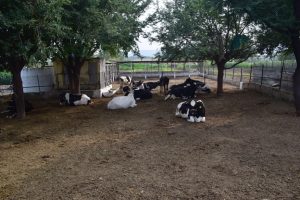Know Why Washing a Cow Daily is Harmful?
Today I read a comment in the social media written by a person who claims to be ‘Tradition Expert’, ‘Historian’, ‘Culturist’, and expert in several other disciplines recommending that cows should be bathed and scrubbed daily in the morning. He gave a whole list of work to do in the cow farm, such as, giving rest to cows between 4-6 pm, offering feed two times, etc. Obviously, this gentleman is not aware of cow physiology and anatomy and probably has never managed any cow himself. Giving wash to cows twice a day is a wrong practice followed only in India and other adjoining countries. None of the dairy-developed or other countries does this as it has no scientific basis and would prove harmful to cows. Spending four hours daily to wash 100 cows is an unnecessary big burden to the farmworkers. This practice originated from a bad and anti-cow practice of tethering (tying)cows with a narrow leash on a cement concrete or brick floor forcing cows to sit and lie on a urine-dung-soiled floor. For this forced uncleanliness, washing cows and floors twice a day becomes necessary. Picking up dung and washing even on a small farm takes 2-3 hours of work from the labourer.

Why it is harmful to Cow?
Cowskin consists of dense and thick hair layer and secretes protective oily because of unique secretions, which repels water. Try to put some water on the skin and it will just drop off, without leaving any trail. Washing leads to loss of skin oiliness, which makes it more vulnerable. Most of the dairies are in water-scarce areas and if per cow even if 50 L water is used twice a day, it is a waste of precious natural resources. The washed water gets into the drainage, resulting in clogs and other hygiene issues. All these issues are due to one bad practice- tying cows all the time.
What is the solution?
It is very simple, keep cows loose, so they move around voluntarily. When given a choice cows will always sit on dry ground. Never opt for hard cement concrete or brick floor in India, as our farmers cannot afford to bed. Rubber mats are not ideal as still these need to be washed and the problem of tick breeding underneath. Go natural- in my experience, a well-laid earth floor that absorbs urine and water in dung is the best cost-effective solution. The key issue is that the cow house should remain dry all the time. This can be achieved in India simply by keeping 75-80% of the cow house open to the sun, and only a small shed without a brick wall (or a short wall). This will also ensure excellent ventilation. A moist or humid environment is an invitation to all kinds of diseases. If you want to know more about such housing models, please visit indiancattle.com, and you can access excellent models built by the farmers themselves.
Please remember, tying cows all the time also hinders their normal activity and should be regarded as cruelty. We, in India, regard cows with great reverence hence they also deserve the freedom to mix and move in groups and express normal sexual behaviour during the oestrus period. Cows need at least 8-10 hours of rest and equal time on rumination. Their physiology is to eat and drink water 6-8 times a day. If you want to be a successful milk producer, the keys are- cow house with well-laid earth-floor, protected with an iron/wood compound fence, cows lose all the time and feeding and watering them as per their need. Please visit www.indiancattle.com to see excellent videos on the opinion of a number of farmers on cow-comfort management and how they are reaping good profits and rest-time for themselves. Without any exception they claim- note more than 3-4 hours of work daily, no washing of cows and floor, picking dry dung in 2-3 months, easy heat detection, a comfortable cow with good rest and rumination, leading to health and NO MASTITIS.
The author is a senior veterinarian and former Dean, Faculty of Veterinary Sciences, who has wide experience of working with dairy farmers and dairy processors
Dr Abdul Samad
Former Dean and Director of Instructions, MAFSU, Nagpur and
Ex-Associate Dean, Bombay Veterinary College
